
Most often. You will find me carrying my EDC in an IWB holster just off my right hip. Over the years there has been a variety of holsters to house the various handguns that have been carried…with a 1911-based pistol being the dominate carry. Shoulder holster systems have also made their way into my carry methods, although they constitute the minority of my holster collection.
My first shoulder holster system was the GALCO Classic Lite for the Sig Sauer P239, a single-stack 9mm pistol that is no longer made and has become a safe queen due to that fact. A GALCO Miami Classic II followed for the 1911. Breaking the GALCO trend was a shoulder holster system from FALCO leather for the CZ 75 series of pistols.
Lately, I have been favoring the Glock G48 as a summer EDC PDA. While I do have several IWB holsters for the G48, I needed a shoulder holster system that would accommodate several models of Glock pistols rather than a holster dedicated to a single pistol…and it had to be light in terms of carry and finances.
I was inclined to purchase another GALCO Miami Classic II, however, the price of the system was beyond my reach for a holster that would not be worn every day. The system would be residing in my holster bin until I needed it for an occasional outing when a shoulder holster system would fit the bill for a comfortable, concealed carry. The Classic Lite Shoulder System from GALCO seemed to fit what I needed and I felt comfortable with the price.
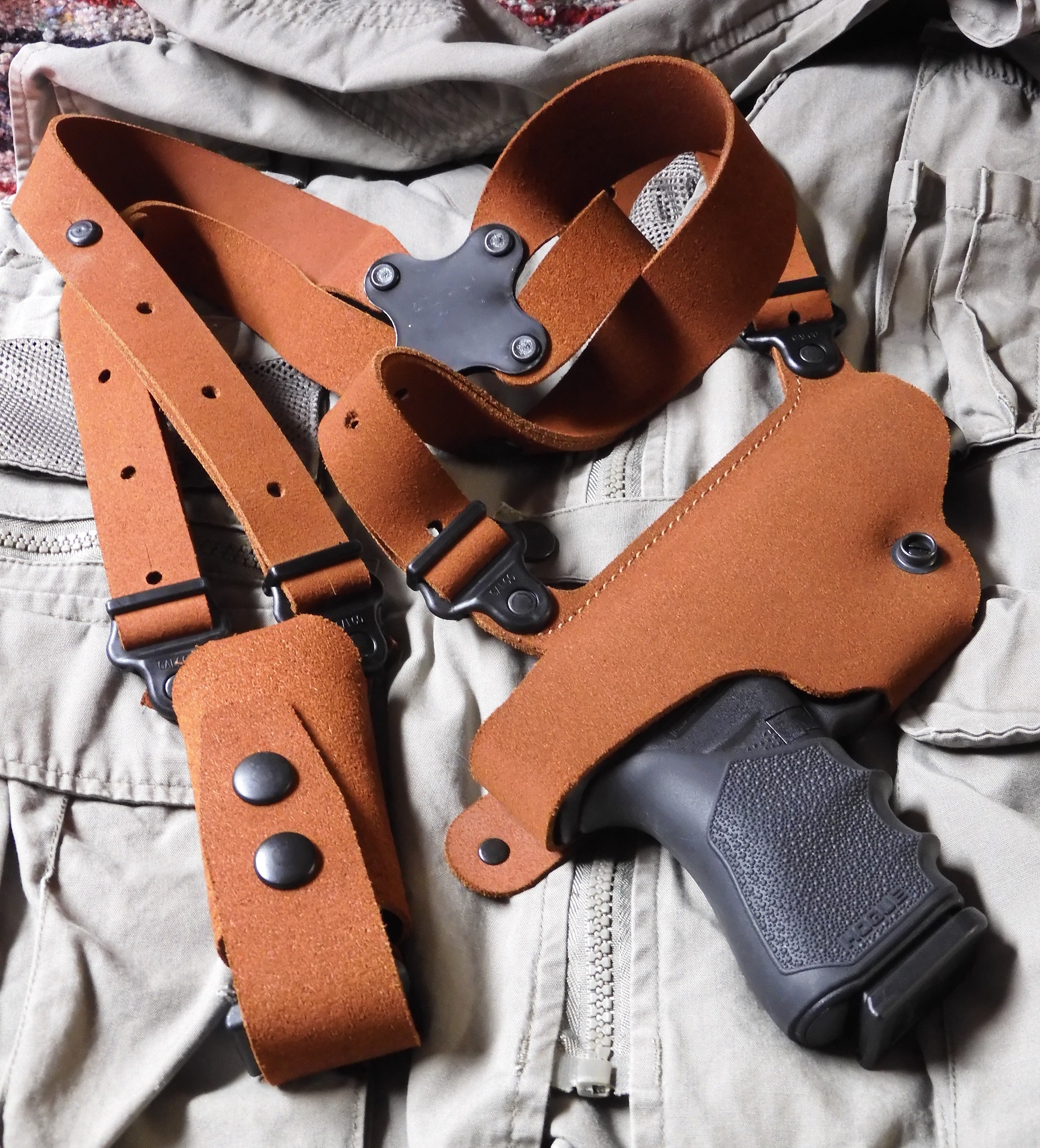
The GALCO Classic Lite Shoulder System, aside from housing the Glock G48, is also compatible with the Glock G19, G19X, G22, G23, G27, G31, G32, G33, G34, G35, G36, and G45 pistols.
The GALCO Classis Lite Shoulder System is a composite of three major components: Harness, Holster, and Magazine Carrier. Harness fasteners are also included. This version of the Classic Lite came with a single magazine carrier. I opted, however, to separately purchase a double magazine carrier from GALCO. With 10+1 in the pistol, 20-rounds in two magazines made me feel more comfortable that one 10-round magazine.
The system is made from natural-color, premium center cut steerhide. “Premium Center Cut Steerhide™ is an extremely durable steerhide with the outer and inner layers removed, resulting in a napped texture on both sides of the leather. It has an outer layer finish that is ideal for inside the waistband and pocket holsters due to the natural “grabbing” ability of the napped leather. Center Cut Steerhide works equally well for general holster designs both because of its sturdiness and because its exterior does not show scuffing or scratches.” – Source: GALCO.
The holster is intended for part-time carry or for carry around the homestead and, for me, does not need to be highly finished but does need to be functional. And, although the holster can fit a variety of Glock pistols, I just needed for it to house the G48 (at least at this time).
The holster is not formed leather, as with the more expensive Miami Classic II holster. This means that the mouth of the holster does not remain open after the pistol is removed. It does mean that the holster easily conforms to the pistol’s shape and no serious break-in is required due to the flexibility of the leather.
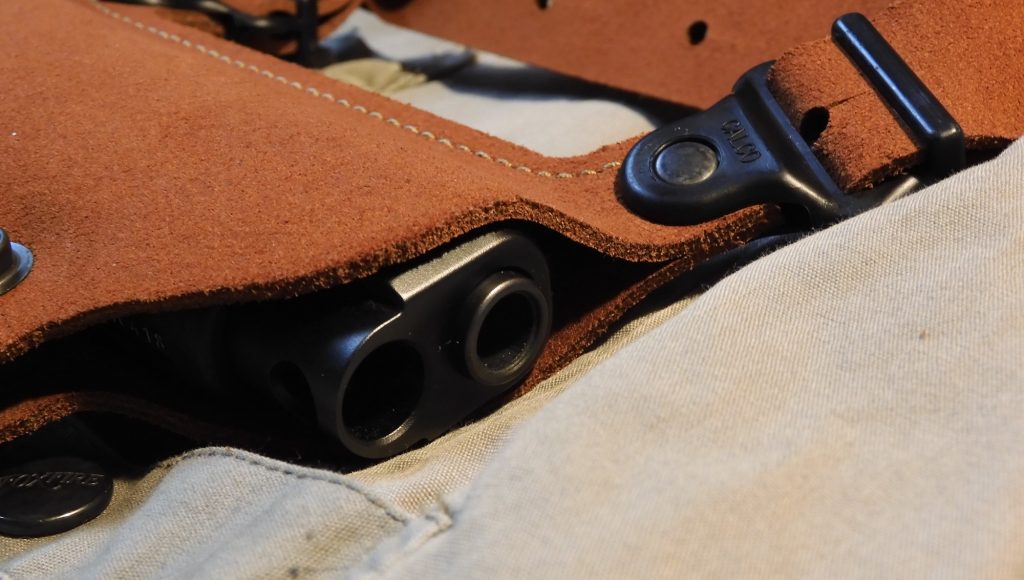
The depth of the holster is perfect for the slide length of the Glock G48 and other similar length Glock pistols. The slide of the G48 just slightly peeks out from the end of the holster with the front sight adequately protected. Pistols like the G26 and G36 also benefit from this holster, as the shorter slide is fully protected.
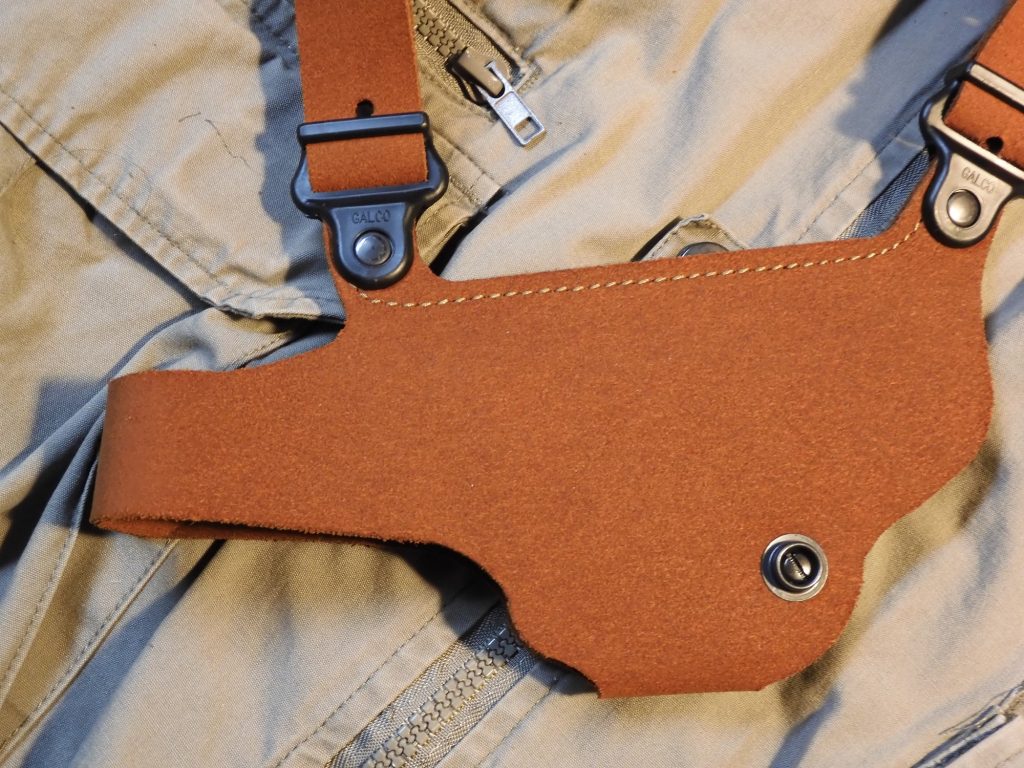
Pistol retention is not only from the tension provided by the width of the holster but also from an adjustable trigger tension screw, which also serves as an anchor point for the (separately purchased) tie-down strap, and the thumb break strap. If I were to use a shoulder holster system every day, it would not be a “soft” system like the GALCO Classic Lite Shoulder System but would be a heavier leather, form-fitting system like the Miami Classic II system. But, for occasional use, the GALCO Classic Lite is more than adequate.
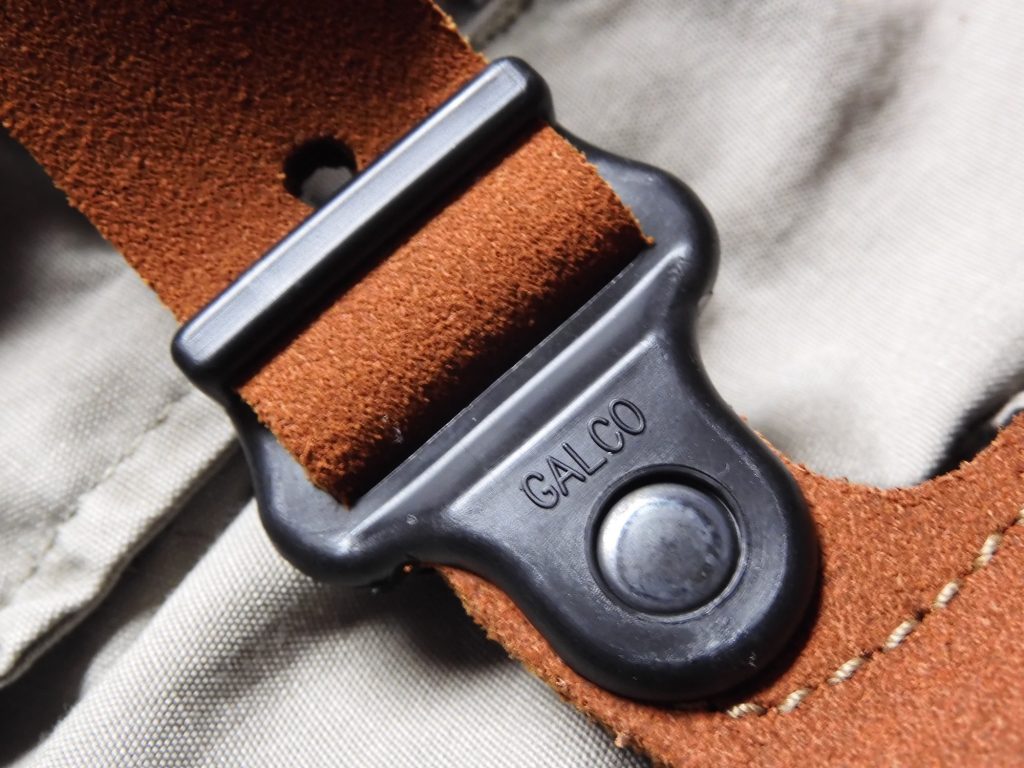
Substantial mounting points (polymer) provide secure mounting of the holster and magazine pouch.
As with any shoulder holster system made of leather, stretching of the material can occur. The user must be aware of any stretching that can affect the firearms retention qualities…pistol or revolver.
Harness Hardware
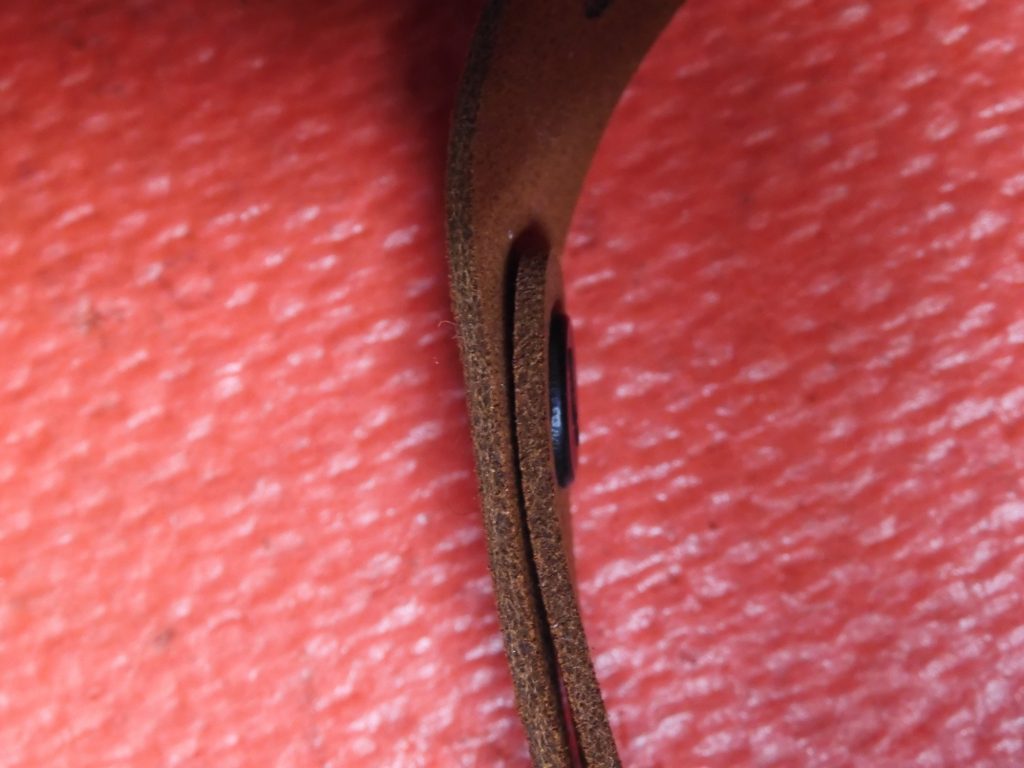
Compared to the earlier version of the Classic Lite Shoulder system that I have, an improved key-hole harness fastener system replaces the earlier screw-and post design. The fasteners are (what seems to be) nylon buttons with a small and large disk. There were 5 (five) fasteners included the system that I received. The small disk is pushed through the key slots in the straps. Key-hole slots make pushing the pins through the leather easy but not without a little effort. (Author’s Note: These buttons and the conventional screw fasteners are on the GALCO website. I ordered a spare set of both )
Assembly and Adjustment
Galco’s Mike Barham and Dave Starin discuss and demonstrate how to correctly assemble, adjust and safely use a Galco shoulder holster system. If you desire, also check out a video from hrfunk (Galco Classic Lite Shoulder Holster: Review & Tutorial).
The system should be balanced on your body. Some like the holster carried low and some like it carried high. The cant of the holster is adjustable. Some, like me, like a slight upward cant while some like a downward cant, while some like a neutral cant. Just remember that you will be reaching across your body to retrieve the pistol and some may have more body than others to reach around. It may take wearing the holster for some time before you decide to readjust the cant.
How you are going to wear a shoulder system may require a decision. For me, the shoulder system will be worn over a T-shirt and under an open loose-fitting outer shirt. In most cases I am also wearing a (non-tactical looking) photographer’s vest (my man purse) even during the hot summer months here in Georgia. (Note that while the folks that I work with are used to seeing me wearing my man-purse, people outside of work are not and I sometimes get inquiring looks.) The photographer’s vest (my man purse) allows me to carry a notepad, writing utensils, wallet, cell phone, cellphone earpiece, flashlight, and other sundry things (Slim Jim snacks?) that I use throughout the day (or when needed)…and the vest affords me another layer of clothing to conceal the system. I have actually carried a camera or two when working or when out among the English.
I have also worn shoulder rigs under a buttoned shirt. I have several shirts with snaps rather than buttons. It is far easier to pop snaps than unbutton buttons if the need arises to obtain your PDA from a shoulder system.
In colder months, a heavier vest is usually worn, which allows me to better conceal the system. More on carry in a bit.
Once you assemble a Galco shoulder system, it can be said that you pretty much assemble them all. It took me all of fifteen minutes to assemble and perform a final adjustment, as I know exactly where I like my shoulders rigs setting on my body. The provided nylon buttons make it much easier and faster to assemble the rig as compared to using screws and screw posts.
Note that you should wear your system around the house to let it settle in on your body. You can re-adjust if necessary. I wore mine for several days before I decided to up the cant of the holster a tad.
Depending on your body size, you may have some excess strap to contend with. The end of the strap can be cut off but I prefer to leave what remains of the strap alone.
Options
I opted to purchase the offside tiedown system. Although the weight of a fully loaded G48 and a dual magazine carrier should offset itself in weight distribution, I felt that using the offside tiedown system would ensure that the shoulder assembly would not shift on the body. I found, though, that the tiedowns were more of a hindrance than a help. Personally, I would like to see GALCO come out with a better tiedown system than what has been available; The shoulder system needs a more adjustable, simpler tiedown system for the holster and magazine carrier…one that can better accommodate different distances from the holster and magazine carrier to the belt. (Author’s Note: I may design one myself. I do like the system used on the Monarch system by Andrews Leather that has an adjustable strap that connects the holster and magazine pouch around the back of the body.) However, there has been no problem with the rig shifting on the body under normal carrying conditions.
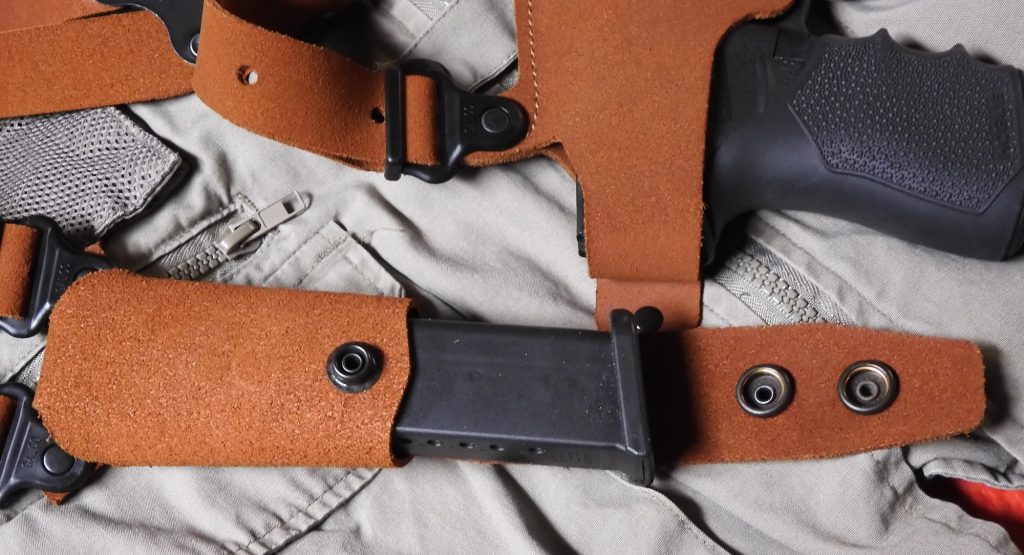
The GALCO Classic Lite Shoulder System comes with a single magazine pouch. I, however, decided to order a two-magazine pouch simply to satisfy my own comfort level with carrying two spare magazines. The single magazine pouch, as came with the holster, will also accommodate magazines intended for the G19, G19X, G22, G23, G27, G31, G32, G33, G34, G35, G36, and G45.
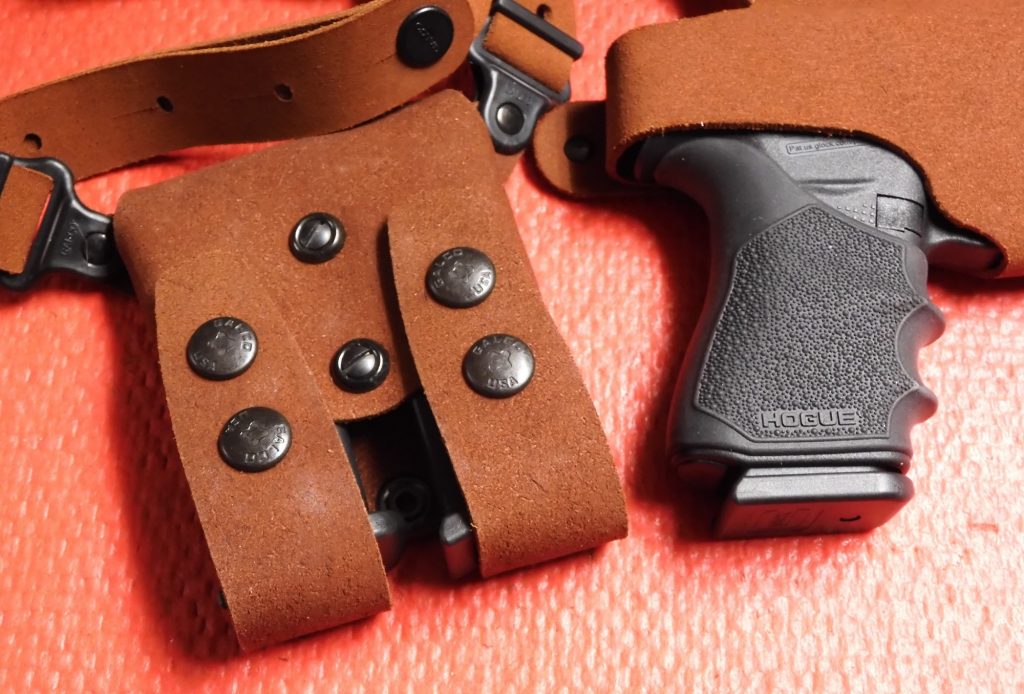
With the single-pouch or double-pouch magazine holder, you will notice the looped piece at the bottom of the carrier. This can be swung out of the way if you decide, as I did, and not use the tiedown system. The double magazine pouch, on the other hand (literally) will hold G26, G43X, G45, G48, G27, G29, and G36, magazines. You may also notice the dual-button snaps and tension adjustments on the double-magazine pouch. Longer magazines, for example Glock G17 magazines, can also be carried due to the dual-snap enclosure…if a compatible pistol (not the G48) is carried. Many consider carrying higher-capacity magazines as spares.
Carrying, Drawing, and Holstering
It should be obvious that shoulder carry is quite different from carrying your EDC on your hip or appendix carry. Two of the safety issues when wearing a shoulder holster is that the barrel points to those behind you and you may cross your own body when drawing the firearm from the holster. But, face the fact that the muzzle is going to be pointed at something regardless of the method of carry. My preferred method of carry is just off the right hip. That not saying that I have not carried with other methods such as cross-draw and shoulder carry. You will never, however, see me carry in the appendix position with any pistol or revolver.
Obviously, safety is a prime factor regardless of how you carry your firearm. The golden rule of firearms is to never place your finger on the trigger until you are ready to shoot. In fact, your trigger finger should never be in the trigger guard until you are ready to shoot. Firearms are not designed to fire by themselves (although several instances have been noted due to defects from being dropped) but require human intervention to do so, either intentionally or by operator error.
In the YouTube video” Shoulder Holsters: Drawing Safely” the author shows one method of drawing and holstering safely with a shoulder holster. The method shown, however, may not work in all situations. For example, when being attacked by a person with a knife or blunt object, a natural tendency for a right-handed person is to get the left hand and arm up in a defensive position and try to block or neutralize the attack. This may be true regardless of the method of carry. The right hand may be trying to grab your defensive firearm at the same time or push someone out of the way of the attack.
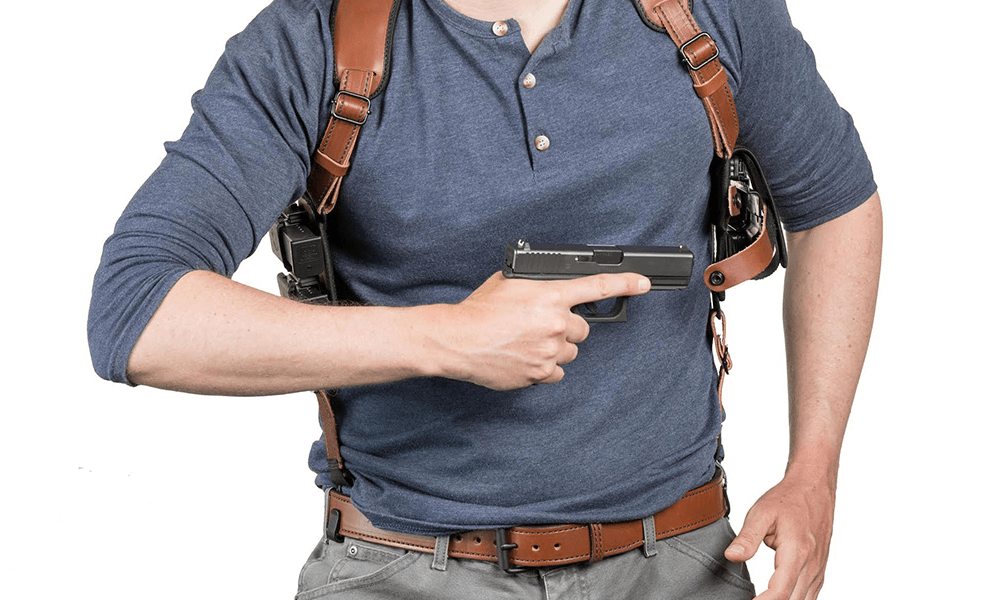
I was trained, as a LEO, in the “interview stance,” a stance where the body was bladed slightly left-forward when interviewing (since I am right-handed). Click here to learn more about the interview stance. My shooting stance (a modified Weaver) is a take-off from this interview stance. While this stance is ideal for strong-side carry (right, in my case), which keeps the firearm away from the interviewee, this stance may not seem ideal for shoulder carry (left side forward), however. While trying to keep myself from getting off on a tangent, I would suggest that you pursue some training in handgun retention techniques. I learned with and then trained others in the Lindell Handgun Retention System and techniques, which was fine for uniformed officers. Unfortunately, there is no method specific to retaining your handgun when it is in a shoulder holster. Most LEO training encompasses handgun retention from a security holster mounted OWB on a duty belt and no consideration, or training program, addresses the challenges of shoulder holster handgun retention. In any case, distance is your friend. I will just say this, if someone tries to take your firearm away from you, you will be fighting for your life.
A shoulder holster is not as stable as a belt holster (OWB or IWB) and will move, albeit limited, about the body. Using a tie-down on my firearm side helps to mitigate some, but not all, of this movement of the holster. Even if my left hand is busy fending someone off me, this limited movement of the shoulder holster aids in my getting the firearm out of the holster as quickly as possible and without using my left hand to assist. Unfortunately, I do not care for the GALCO tied-down system.
The firearm, when drawn, is kept as close to my body as possible and muzzle pointed slightly down as the sweep progresses. If I am target shooting, my left hand comes around to naturally support the firearm as I get on target…up and out. In a defensive situation, I may not have the luxury of using both hands and need to fire one-handed. (Note: In a defensive situation, hitting any part of an aggressor’s body will do (and if the muzzle is pointed to the lower extremity of the assailant, why not take advantage of that?)).

There is also the thumb break on the shoulder holster with a substantial metal backing to ensure that unsnapping the thumb break strap is positive with no give. The thumb break has to be released before the firearm can be drawn from the holster. If I carry a firearm OWB (concealed or not) or shoulder carry, you can bet there will be a secured thumb break on the holster. Unlatching a thumb break is as natural to me as pressing down on a 1911 safety. Never carry a firearm in a shoulder holster without a thumb break snapped shut. With that said, getting to that thumb break is tantamount to successfully releasing the firearm from the holster. I would venture to say that you will overshoot the thumb break release in most cases (especially under pressure) regardless of the position of the holster. You owe it to yourself to practice, practice, practice drawing from a shoulder holster if that holster houses your life-saving device.
For another source to learn a draw and re-holstering technique for shoulder holsters, view: Tactical Tuesday – Shoulder Holster Draw.
My usual method is to place my hand flat against my chest and move the hand inward toward the firearm. Using this method, I have never had to clear clothing away from the firearm. A slight bend forward also helps to clear clothing from around the holster.
What about holstering a firearm in a shoulder holster? Like with other carry methods the “fast out, slow in” adage applies. Holstering a firearm in a shoulder holster takes a little more consideration than with other holsters. Obviously the first step is finger off of the trigger. Ensure that all outer clothing is cleared from the path of holstering the firearm. Holstering is normally a two-handed technique and you must consider the position of the thumb break. Normally, I will grasp the holster with my left hand while using the trigger finger of my left hand to pull the thumb break strap away from the holster. The thumb break strap on the GALCO Classic Lite Shoulder System is not as stiff as that found on, say, the GALCO Miami Classic II Shoulder System. The thumb break strap can find its way into a trigger guard. I have two methods that I use and I’ll tell you about my primary method. But first let’s look, and I do mean look, at something else…the holster.
While I have holstered a firearm into a holster by feel many times, it is advised by many to “look the gun into the holster.”
First is to, as I mentioned, secure the holster. You may have to clear any outer clothing to do so. I keep my trigger finger alongside the firearm, thus covering the trigger guard. I look at the holster as the firearm is inserted into the holster while my trigger finger moves beneath the thumb break strap. I then push outward against the thumb break strap, which forces the thumb beak strap away from the firearm and, more importantly, away from the trigger guard. The alternative is to use the thumb or fingers of the hand holding the holster to pull the retaining strap away from the mouth of the holster, which provides a clear path into the holster for the pistol to travel. Slowly insert the firearm into the holster. In the case of the GALCO Classic Lite holster, and because it is more flexible than a form-fitted holster, the trigger guard may catch the mouth of the holster, which will bend inward slightly. It usually takes a slight twist of the firearm for the trigger guard (especially with a pistol that has a square-off trigger guard like the Glock) to center the trigger guard in the mouth of the holster.
Once I am assured that the firearm’s trigger housing is well within the holster, I use my thumb to push against the rear of the slide (in the case of an exposed hammer revolver or hammer-fired semi-automatic, the thumb is placed against the hammer) and the palm of my hand against the rear of the grip to complete the insertion. The thumb break strap is then positioned for snapping and then firmly snapped into place. With that said, and with the GALCO Classic Lite Shoulder System, the pistol has a tendency to move a bit further into the holster, as there is some flexibility in this soft holster that is not found in form-fitted holsters. I must slowly pull the grip of the firearm as if I was going to draw it from the holster; By doing so, this places the rear of the slide directly against the thumb break strap and I am assured that the pistol is firmly secured. The tension of the holster material and thumb break strap against the pistol ensures that the pistol is not going to fall out of the holster.
Other Clothing Considerations
I mentioned my normal daily wear earlier (photog vest and all). There are, however, occasions where I wear a very loose-fitting sweatshirt as my outer wear. The shoulder holster is, of course, beneath the sweatshirt and deeply concealed. As before, I have two options and both are dependent on how busy my support hand is.
If my left hand is not busy fending off the bad person, I use it to lift the bottom of the sweatshirt and I use my strong hand to go beneath the sweatshirt and head for the firearm. If my left hand is busy, I must use my strong hand to get beneath the sweatshirt without assistance from my other hand. However, the same can be said if I was carrying strong side IWB…it is just a matter of the location of the firearm.
With drawing the firearm from a shoulder holster from beneath a sweatshirt, once my thumb releases the thumb break, the thumb is positioned on the rear of the slide so that nothing on the slide can catch against the sweatshirt material. Once clear of the sweatshirt, the thumb moves alongside the slide. This movement has been practiced many times with my 1911 so that it has become second nature to me. Bring the 1911 to bear means that the thumb safety is wiped off in the process. With a pistol without a thumb safety there is simply nothing to press, but the thumb movement is ingrained in me nonetheless.
Carrying a firearm in a shoulder holster requires an outer garment be worn at all times (in most cases). After all, concealed is concealed, right? While my sport coats are tailored for IWB carry on the waist, I must admit that they are not tailored for shoulder holster carry. I rarely wear sport coats anymore so wearing one is not a concern of mine. However, I do wear vests. The arm holes can unintentionally reveal the straps of a shoulder holster. My preference is to wear the shoulder holster (and other holsters) under a one-size-larger-than-normal open front shirt with the vest over top of the shirt. But, that’s just me. You need to find your way to dress around the gun.
Body Build Considerations
A shoulder holster setup is not for everybody. Simply put, if it takes considerable effort to reach around your body and grasp the butt of the gun residing in a shoulder rig, perhaps a shoulder holster setup is not for you. That’s not to say that it cannot be done, it is to say that you may consider another mode of carry. This is akin to appendix carry when you have a substantial stomach; It may work but may not be the best of ideas…from several standpoints.
Printing
Some shoulder holster systems are simply too bulky to wear and conceal properly. Some are tactical in nature and are intended to be carried openly.
Wearing a shoulder holster system concealed means that the wearer must be cognizant of how they dress. Loose clothing is the order of the day, but there also the risk of an outer covering blowing open to expose what you are carrying, if only briefly. I like wearing heavier than normal-for-the-season shirts to help alleviate accidental blowout when the shirt is open. This is augmented by my other layer of non-tactical Photographer’s Vest (or, on occasion, a sport coat).
The possibility of printing while bending over is also a risk when wearing shoulder system, but no greater a risk than with carrying IWB on the hip. One should always be cognizant of body position when carrying a concealed firearm and take precautions to prevent showing others that you are armed, accordingly.
Available for the GALCO Classic Lite Shoulder System is the offside tiedown system, which helps mitigate movement of the holster and magazine pouch. One, or both, retention straps may be used. Personally, I do not care for the holster tiedown. It is two pieces of leather where one piece of leather with multiple snap points would have sufficed. One company, Andrews Leathers, uses a strap that connects the holster and magazine carrier together on the Monarch Leather Rig. The adjustable strap extends around the back and helps to prevent the holster and magazine carrier from falling forward; The shoulder rig acts as a unit rather than two separate pieces just dangling. (Author’s Note: When I am able to get my hands on a Sig Sauer P229 M11-A1, the Monarch Leather Rig from Andrews Leather will be the top choice for the shoulder rig for that pistol.)
A Word about Firearm Compatibility
As has been noted, the GALCO Classic Lite Shoulder system that I purchased for the Glock G48 is compatible a variety of Glock pistols such the G19, G19X, G22, G23, G27, G31, G32, G33, G34, G35, G36, and G45. However, there is a caveat. The caveat is that while I could use the holster for these firearms, doing so may mitigate using it to house the G48. Let me explain.
The holster is not molded to a specific Glock but rather is a one-size-fits all with these size pistols. The G48 fits fine with very little movement within the holster, but there is a little from front to rear. If I decided to, say, use the rig to house my Glock G45, the holster would take a bit of side-to-side stretching to accommodate the wider slide; The slide width of the Glock G48 is 0.087-inch while the slide width of the Glock G45 (and others in the list of compatible pistols) is at 1.0-inch. If the holster was sized for these other compatible pistols, the odds are that it would no longer serve me to house the G48, as the pistol would fit too loose and the holster’s retention capabilities would be compromised. As it is, the tensioning screw provides adequate enough tension against the G48’s slide and frame. To fit a larger pistol, like a G45 for example, I would need to back the tension screw out and then allow the G45 to “size’ the pistol.
Unlike a form-fitted holster, for example the GALCO Miami Classic II, and while the holster requires a break-in, it is doubtful that the G48 could be used without giving up a lot in the retention department. I have experimented inserting the G48 into a holster intended for the G19 and the fit is just too loose for my comfort. In short, the GALCO Classic Lite Shoulder System has become a dedicated G48 holster, until I decide that I no longer need the G48 and will step up to the G45 or another compatible pistol in the list. There is also the possibility that the holster can be used for pistols similar in design and size to a Glock, as the flexibility of the holster opens that possibility.
Bonus Material
Although this article is primarily a review of the GALCO Classic Lite Shoulder System, there are pros and cons of the system…any shoulder holster system. I have included them here for your perusal.
Pros of Shoulder Holsters:
- While you are seat-belted in a car, a shoulder holster offers fast access to your gun. Getting to a strong-side holster is a difficult task when you’re strapped into a car seat, but it is much easier to get to a shoulder rig. This is why a large chunk of the shoulder holster-wearing population is made up of pilots, drivers who spend a lot of time behind the wheel, and bodyguard/security personnel. This same feature could benefit those who work at a desk.
- Concealed carrying in cold weather can be tough, as clothing layers can slow you down. A shoulder holster will generally only be under one layer, not multiple layers like a belt holster.
- This style of carry offers more space and better weight-bearing ability required by a heavier gun. The weight of your gun and spare ammo will be taken off your belt (and your lower back) and distributed evenly across your shoulders, negating the need for a belt entirely. If you have back problems, you might prefer the shoulder rig for this reason, and quite a few female gun carriers use the shoulder rig because they don’t need to wear pants or skirts with the belt loops required to accommodate a sturdy gun belt.
- Especially with horizontal holsters, you will be able to get your hand on your weapon in an inconspicuous manner. When you spot approaching trouble, it’s easy to just cross your arms in front and get a firing grip on your weapon without alarming anyone or giving yourself away.
- Your gun and spare ammo are combined in one convenient portable package. It takes a lot longer to thread a holster and ammo carrier onto your belt than it does to grab your shoulder rig as you head out the door. Also, when everything is combined, you’re not likely to forget anything. To balance out the gun you can carry extra magazines, or any combination of magazines, flashlight, knife, etc.
Cons of Shoulder Holsters:
- It is very easy to have your draw blocked or pinned completely by an adversary who manages to grapple with you or back you against a wall. The gun is then easily accessible to that assailant.
- It is very difficult/ nearly impossible to draw if your chest is pressed against a wall or the ground.
- You will need to wear a cover garment at all times. A belt holster will require that as well, but with a belt holster it is easier to conceal, and you have a wider range of clothing concealing options.
- Our hands are normally relaxed and at our sides, making it much faster and easier to locate and draw a gun from a belt holster. Reaching back under the arm can be a more difficult maneuver to learn and execute properly. That is why, a shoulder rig offers a slower draw, although this con is somewhat mitigated by the ability to access and grip your gun in a covert manner. Still, it does generally take more time to get the muzzle pointed at the target.
- Some might find the weight trade between the belt and shoulders to be uncomfortable.
- The reason most people consider these holsters a gun safety problem is that with shoulder holsters, you’re inherently sweeping bystanders to get on target. No one is claiming that people are often being killed because of shoulder holsters, but it’s a highly specialized holster with some specific training requirements needed to master its use, and not everyone puts in that effort. This safety concern can be addressed with the proper training, but people shy away from it because you never know what the level of training the person next to you wearing it has.
- If the shoulder holster becomes your default concealed carry option, be aware that virtually all shooting schools prohibit their use in class, few ranges allow them on the shooting line, and I know of no shooting competition which will allow them. Unless you have access to outside rangers, you’ll be getting much less practice time with them. That is not to say that you cannot practice at home with an un-loaded firearm. I find that the use of “Snap Caps” enable me to practice the draw stroke and dry-fire the firearm safely.
Summing it Up
While I made an attempt to cover some things regarding the product and shoulder carry in general, I could not cover all things.
Shoulder holster carry is not something that I do every day. In fact, if I carry in a shoulder rig when out among the English a half dozen times a year, I would surprise myself. I find myself using a shoulder rig when I am at home more often than not. Let me explain.
Lounging in my easy chair or lying on the couch watching a movie in my sweats, or even when working from home where business attire is not needed, a shoulder rig is the cat’s meow. If you have ever tried to wear an IWB holster with sweat pants then the expression “Dropping Your Drawers” takes on a whole different meaning. A quality shoulder system can be comfortably worn day or night around the house with my spouse being none the wiser that I am carrying a firearm. I may also carry in a belly band, depending on my mood.
The GALCO Classic Lite Shoulder System for my Glock G48 is my choice for a simple, but effective and inexpensive means to carry my PDA when driving, moving about the populace, or lounging around the house. The GALCO Classic Lite Shoulder System is just what it is, a light, not bulky, comfortable, and affordable to wear shoulder holster system.
Research the various manufactures of shoulder systems and their products before diving into a shoulder holster system, as these systems range from cheap to extremely expensive. An inexpensive system, like the GALCO Classic Lite or Classic Lite 2.0, may be an easy-on-the-bank-account way of determining if a shoulder system is right for you.
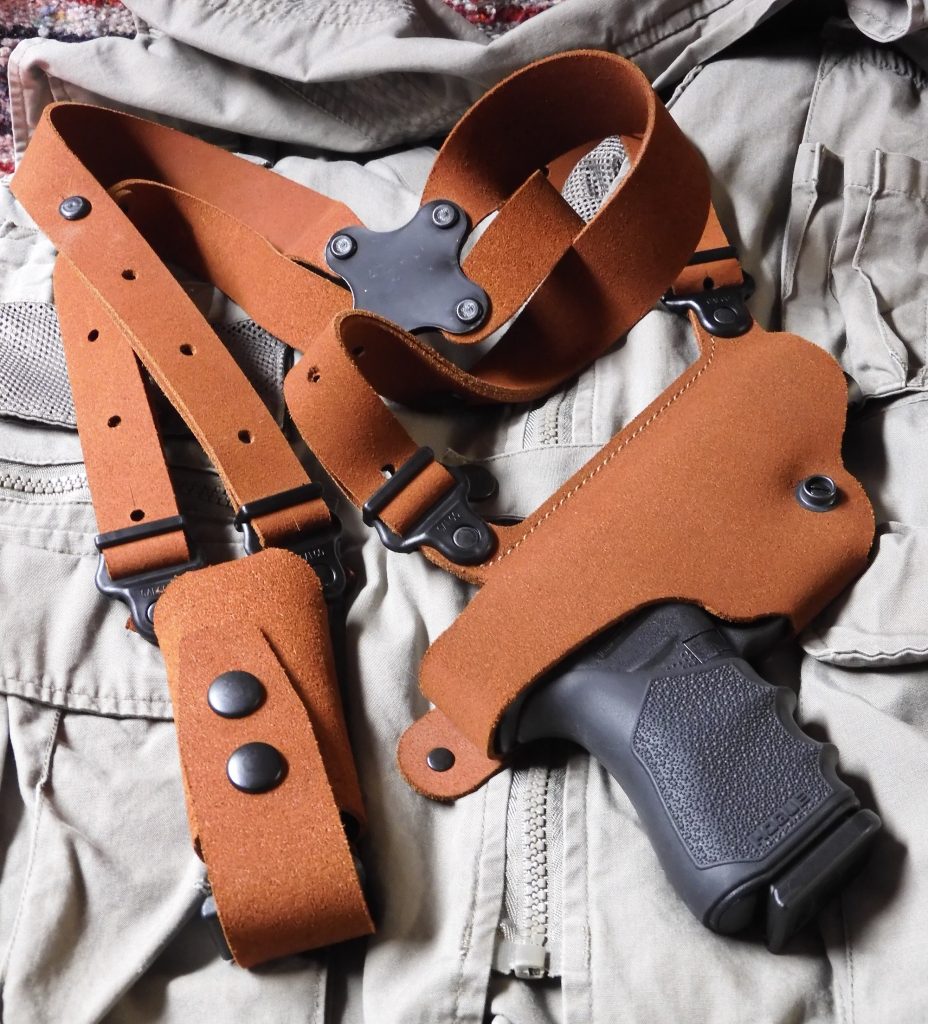
I have confidence in the quality and features of the Classic Lite and Classic Lite 2.0 Shoulder System. This is because Galco uses the same patented and trademarked connectors on these models as on their more expensive rigs. This includes their trademarked clover-shaped Flexalon swivel back plate to ensure the same snug fit and function. The Classic Lite and Classic Lite 2.0 Shoulder Systems have been rated as the best buy in this price range by several sources (aside from Galco, of course).
![]()

